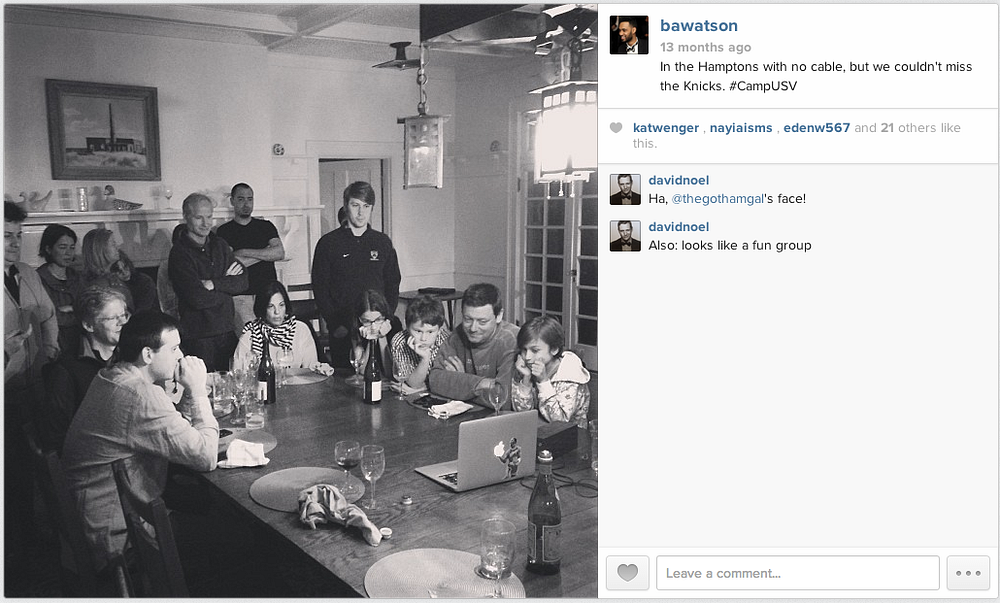Fred Wilson: Today is @bwats last day @usv and he wrote a post on what he learned https://t.co/TS4Ymjg9IS. We should write a post on what he taught us
What I’ve learned in two years at USV
Doing the Job
Believe in something when everyone else doesn’t.

On learning to maneuver your way throughout the firm and the larger tech community >>>
- Don’t spend all of your time at events unless you’re learning something that gives you a better perspective on the marketplace.
- Curate who you follow. You’re letting them in your brain, and you want to surround yourself with the best ideas.
- Prioritize being present. You’ll learn more by giving it your full attention than rushing to take notes.
- Your job is to provide a different perspective to the firm, not only to source investments. Find a space that you love and develop an opinion on it.
- Being a successful VC is as simple as having the conviction to believe in something when everyone else doesn’t. You have to be right when everyone is wrong.
- Aspirations can’t be measured; goals can. Theoretically, aspirations lead to goals. Set them, and track against them.
- Embrace serendipity. Take random meetings, and see where they lead you.
- Don’t be afraid to respectfully say no to things. You shouldn’t waste someone’s time if you’re not the right fit for each other.
- Helping portfolio companies hire talent is the most efficient way to provide value to and from your network. (PS—you should check this out.)
- You’re only at the firm for a few years, while each partner is committed for the long-term. Naturally, the way in which you evaluate an investment (“is this is a hot deal?”) is different than theirs (“am I willing to spend the next 3-5 years with this company?”).
- If you really think the firm should invest in an entrepreneur, your job becomes inception—you need to convince a partner that an investment was their idea. People tend to like the things they find themselves.
- Research in public. Open-source your ideas, and let the world help you build them.
- VC is becoming a service business, and the best marketers are seeing the best deals.
- Leverage community. You have access to many different networks (friends, classmates, co-workers, and portfolio companies), and you shouldn’t be afraid to ask for help.
- VC is about story recognition. Remember the anecdotes (and how they’re resolved), because history often repeats itself.
Only in Union Square
Being selective — doing less—keeps you focused.

There’s something about Union Square Park in NYC. It’s a place where people meet, ideas are exchanged, and values are shared. It’s fitting that USV shares the same name. On USV >>>
- There is a temptation to follow the business cycle (more investments in a bull market, less in a bear period), but you have to be consistent throughout for great returns. Stick to your sweet spot, and don’t sway with the market.
- Your portfolio will change with time, and it’s good practice to constantly re-evaluate your past investments.
- Form an opinion, speak out, and act on what you believe should exist in the world.
- Your reputation is everything. Only make an investment if you are committed for the long term.
- If your investment thesis can’t be summarized in 140 characters, you’re being too prescriptive.
- You should always discuss your investment thesis publicly.
- Look for a CEO with product intuition and empathy.
- Shift from telling entrepreneurs what to do, to creating paths that help them learn from each other.
- The best networks (e.g. Waze) started with a “narrow wedge” use-case for a niche audience (i.e. crowdsourcing speed traps on the highway), then show network value as they scale.
- Data network effects can be stronger than people network effects, but try to avoid companies where there are diminishing marginal returns to data. Having a 2% margin of error when n=50 and a 1.75% margin of error when n=50,000 means your network isn’t defensible.
- Be loyal to your LPs. Never forget those who took a chance on you, and always do what you can to support them.
- Having the full team meet in-person, once a week, every single week is the best way to share knowledge and keep the team accountable.
- You can use a Monte Carlo simulation to predict fund reserves (how much you’re saving for follow-on investments). However, the data is only as good as often as you update it, and capital allocation requires finesse.
- Internal financing rounds are tempting, but sometimes it’s good to add another credible voice around the table.
- Don’t make your portfolio companies do extra work (e.g. filling out an internal report), unless there’s clear value for them.
- There’s always a point in which companies are no longer valued on network growth (i.e. engagement) and are evaluated on revenue growth.
- Being selective — doing less—keeps you focused.
- Having a smaller fund helps you stay honest and flexible. There are only a few billion dollar, early-stage investment opportunities each year. When you have a small fund (say, $150mm) with a 15% target ownership percentage, you only need a single billion-dollar exit to return the entire fund. As your fund size gets larger, the required number of billion-dollar exits increases.
- There is a “1/3, 1/3, 1/3″ rule of portfolio success, but you have to love all of your companies equally. You often spend the most time with struggling companies. Supporting your portfolio is what defines your firm’s reputation.
- Having a later-stage fund to double-down on your top investments allows you to supplement your early-stage fund by providing a different risk-return structure to your LPs and additional support to companies that achieve major scale.
- As a firm, you should encourage each person to publicly share their own perspective. In fact, it will create deal flow and open up new opportunities.
- You shouldn’t showcase each investment by partner. The firm is a partnership, not a collection of individual decisions.
The Fundraising Process
Raising money is a trade-off between valuation and control.
On a startup’s fundraising process >>>
- In a seed round, you should use a standard term sheet and agree on basic terms to keep legal fees low.
- A simple Series A term sheet should have no special dividends, no registration rights, and limited protective provisions — just a simple 1x, non-participating preferred with standard anti-dilution, conversion, pre-emptive, ROFR and co-sale rights.
- Raising money is a trade-off between valuation and control.
- The success of a venture deal, in general, is the inverse proportion of the number of venture capitalists (non-independent, non-operators) on a startup’s Board of Directors.
- New York VCs (and other east coasters) have an advantage to win European startup financings — mainly because of the time zone difference between Europe and Silicon Valley.
- When an entrepreneur is planning to raise money, providing potential investors with an abridged monthly update is a great way of keeping VCs engaged and interested. (But please, ask first. The companies that add every investor to their list without consent are the worst.)
- All VCs have low attention spans. Use no more than 10-15 slides in a partnership meeting.
- If you’re pitching a VC partnership and you’re doing all the talking, that’s a bad sign. You want to pique their interest enough to get them talking amongst themselves.
A simple Seed term sheet doesn’t have to be complicated. All you need to know >>>
- How much you’re investing, the price, ownership (“We will invest $1mm at $3mm pre, $4mm post, and purchase 25% of the company.”)
- The size of the option pool. (“There will be a 10% option pool post-closing, which will be included in the pre-money valuation.”)
- The board structure. (“The board will be the two founders plus me.”)
- The stock. (“We will buy plain vanilla preferred stock.”)
- Founder vesting. (“There will be founder vesting, with some acceleration to reflect time spent on the startup so far.”)
- The process. (“If we use standard forms that we are comfortable with that reflect these terms and there are no negotiations, we will forego legal representation.”)
Building a Company
Identify emergent behavior and promote it.

Operating a company is a balance between doing the right thing (strategy) and doing it right (execution). On growing a company >>>
- A great CEO coach can make a huge difference. For other roles, find peer mentors for guidance and support.
- Curated content lists (humans) tend to perform better than “recommended” lists (algorithms).
- Good company culture is when the team feels accountable to each other, implicitly and explicitly.
- Kill features. Edit. Remove an old feature for each one you add.
- Constraints lead to creativity. You’re most creative in 140 characters and when your company is running out of runway.
- You should be projecting your company’s vision about 2 years out, your product about 2 months out, funding/staff/ops about 6-12 months out, and marketing about 3-6 months out.
- Don’t be afraid to share your important stats with your users.

- There are many approaches to product management. Some companies start with design and move to engineering; others write a “press release” and then build the product; others brainstorm and prioritize. Do what feels right for your organization.
- Set and share internal deadlines with the team. Include a buffer to account for outliers, but avoid variable deadlines as much as possible.
- A/B testing is often better than user testing, and you should run them across specific user segments. Men lie, women lie, numbers don’t.
- A culture of collaboration is better than a culture of consensus. Get buy-in from the team, use proactive communication, set clear KPIs, and maintain a sense of alignment.
- The best products are “simple, but perfect.” Make it quick, easy, and delightful for your customers.
- Once you have a core product, the goals should be growth, monetization, and happiness.
- Norms aren’t defined; they exist and evolve. You can’t invent movements, you can only amplify existing ones. Identify emergent behavior and promote it.
- If you’re not being indexed, you’re not being found.
- In a marketplace, the most indicative metric of a community’s health is the cross-pollination of stakeholders. Etsy sellers buy from other Etsy sellers, Kickstarter creators back other Kickstarter creators, and Meetup attendees start new Meetups.
- When dealing with remote teams, every employee (even those in your HQ) should use the same communication system so remote workers have an equal voice.
- When you’re interviewing someone, ask what they don’t/didn’t like at their current/previous job. It gives them a chance to go off on a rant, which can teach you about them and provide insight on whether or not they’re a good fit.
- Marketing a peer network is as simple as storytelling. Create content that galvanizes a passionate audience—no matter how small that audience is.
Market Trends
The future is open, informal, and mobile.
The market changes quickly, and it’s easy to get caught up in the next “hot” thing. You should have an opinion on what’s happening, but always be willing to change your thinking as the broader economy shifts. On the market >>>
- The future is open, informal, and mobile. Instagram did it to photos. Twitter did it to blogging.
- Content will ultimately be free.
- Bundled services (newspapers) ultimately become unbundled (blogs) and are eventually re-aggregated across a different dimension (Twitter).
- We’re moving from single dominant networks with lock-in to light-weight services with interoperability.
- The current market environment is very founder-friendly, and founders want to see a little of themselves in their investors. Diversity is important.
- A 10x revenue multiple is a phenomenal outcome for any M&A transaction.
- You should go public when you’re cash-flow positive with a path to profitability. Growth trumps all… followed by scale and margin.
- Public market investors assign value to companies with high customer retention, particularly SaaS businesses. Higher retention leads to higher revenue multiples.
- Stocks don’t always trade on value, they trade on a catalyst.
- Silicon Valley is about optimizing processes (“how do we make this faster, more efficient?” e.g., Dropbox). NYC is about understanding people (“how do we bring this online?” e.g., Etsy). One isn’t better than the other, but they have different implications.
- Data as art, not data science, is how we’ll derive insights from the world around us.
- Hacking is the new blogging. Apps are content now, and you should produce as many of them as you can.
- Running a network is like urban planning for the internet. It’s a social engineering problem, not an electrical engineering one.
Thanks for reading, and congrats on making it to the end!
What have you learned recently? Find me on the internet, and tell me about it.
